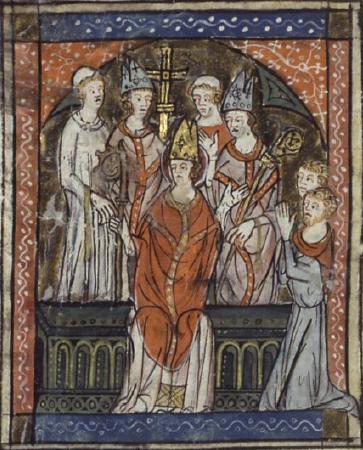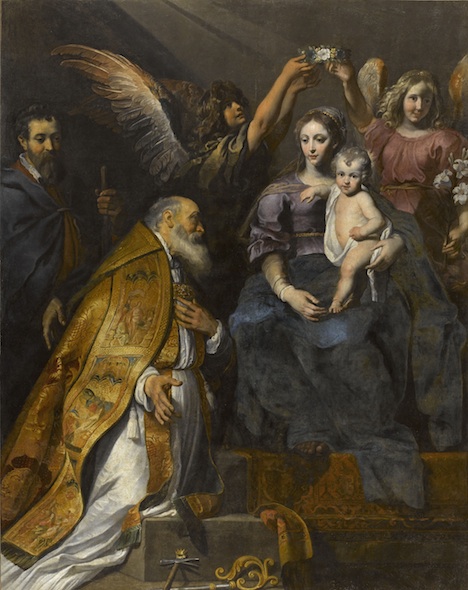|
Mont-Saint-Éloi
Mont-Saint-Éloi (; ) is a commune in the Pas-de-Calais department in the Hauts-de-France region of France northwest of Arras, on the banks of the river Scarpe. Population Mont Saint-Éloi Abbey The monastery was founded in the 7th century by Vindicianus, bishop of Arras and devotee of Saint Eligius. The bishop was buried in the nearby Bois d'Ecoives, but his relics were subsequently removed to the Abbey Church of St. Joseph, which was enlarged in the 11th century. The abbey adopted the Rule of Saint Augustine, and was the motherhouse of St. Botolph's Priory in Colchester. The medieval buildings were demolished in 1750 to make way for a church and convent, necessitated by the aging and shallow foundations of the old abbey. During the French Revolution, the monks left and the abbey was converted into a quarry and pillaged for the stone. What remained of the towers and facade serving as a military observation point during the First World War. In 1915 heavy shelling damaged ... [...More Info...] [...Related Items...] OR: [Wikipedia] [Google] [Baidu] |
Communauté Urbaine D'Arras
The Communauté urbaine d'Arras is the ''communauté urbaine'', an intercommunal structure, centred on the city of Arras. It is located in the Pas-de-Calais department, in the Hauts-de-France region, northern France. It was created in January 1998, replacing the previous ''district urbain d'Arras''. Its area is 306.0 km2. Its population was 108,347 in 2018, of which 41,555 in Arras proper.Comparateur de territoire INSEE. 5 April 2022. Composition The Communauté urbaine d'Arras consists of the following 46 communes:CU d'Arras (N° SIREN : 200033579)BANATIC. Accessed 17 October 202 ... [...More Info...] [...Related Items...] OR: [Wikipedia] [Google] [Baidu] |
Vindicianus
Saint Vindicianus (''Vindician'') () ( 632 – 712) was a bishop of Cambrai-Arras. His Calendar of saints, feast day is 11 March. He is called a spiritual follower of Saint Eligius (Saint Eloi). Life Traditionally, his birthplace is given as Bullecourt, near Bapaume. This is the birthplace indicated in the documents dating much later than the saint's death, but which claim to reproduce an ancient local tradition. Nothing is known of his early years.Van der Essen, Léon. "St. Vindicianus." The Catholic Encyclopedia Vol. 15. New York: Robert Appleton Company, 1912. 2 December 2021 On the death of St. Aubert of Cambrai, Aubert, Bishop of Cambrai-Arras (about 668), Vindicianus was elected his successor. He was bishop of this see in the reign of Theuderic III of Neustria (about 673). [...More Info...] [...Related Items...] OR: [Wikipedia] [Google] [Baidu] |
Communes Of The Pas-de-Calais Department
The following is a list of the 887 communes of the Pas-de-Calais department of France. The communes cooperate in the following intercommunalities (as of 2025):Périmètre des groupements en 2025 BANATIC. Accessed 28 May 2025. * Communauté urbaine d'Arras * Communauté d'agglomération de Béthune-Bruay, Artois-Lys Romane * Communauté d'agglomération du Bo ... [...More Info...] [...Related Items...] OR: [Wikipedia] [Google] [Baidu] |
Communes Of France
A () is a level of administrative divisions of France, administrative division in the France, French Republic. French are analogous to civil townships and incorporated municipality, municipalities in Canada and the United States; ' in Germany; ' in Italy; ' in Spain; or civil parishes in the United Kingdom. are based on historical geographic communities or villages and are vested with significant powers to manage the populations and land of the geographic area covered. The are the fourth-level administrative divisions of France. vary widely in size and area, from large sprawling cities with millions of inhabitants like Paris, to small hamlet (place), hamlets with only a handful of inhabitants. typically are based on pre-existing villages and facilitate local governance. All have names, but not all named geographic areas or groups of people residing together are ( or ), the difference residing in the lack of administrative powers. Except for the Municipal arrondissem ... [...More Info...] [...Related Items...] OR: [Wikipedia] [Google] [Baidu] |
Pas-de-Calais
The Pas-de-Calais (, ' strait of Calais'; ; ) is a department in northern France named after the French designation of the Strait of Dover, which it borders. It has the most communes of all the departments of France, with 890, and is the 8th most populous. It had a population of 1,465,278 in 2019.Populations légales 2019: 62 Pas-de-Calais INSEE The Calais Passage connects to the Port of Calais on the . The Pas-de-Calais borders the departments of [...More Info...] [...Related Items...] OR: [Wikipedia] [Google] [Baidu] |
Departments Of France
In the administrative divisions of France, the department (, ) is one of the three levels of government under the national level ("territorial collectivity, territorial collectivities"), between the Regions of France, administrative regions and the Communes of France, communes. There are a total of 101 departments, consisting of ninety-six departments in metropolitan France, and five Overseas department and region, overseas departments, which are also classified as overseas regions. Departments are further subdivided into 333 Arrondissements of France, arrondissements and 2,054 Cantons of France, cantons (as of 2023). These last two levels of government have no political autonomy, instead serving as the administrative basis for the local organisation of police, fire departments, and, in certain cases, elections. Each department is administered by an elected body called a departmental council (France), departmental council ( , ). From 1800 to April 2015, these were called gene ... [...More Info...] [...Related Items...] OR: [Wikipedia] [Google] [Baidu] |
Region Of France
France is Administrative divisions of France, divided into eighteen administrative regions (, singular ), of which thirteen are located in metropolitan France (in Europe), while the other five are Overseas departments and regions of France, overseas regions (not to be confused with the Overseas collectivity, overseas collectivities, which have a semi-autonomous status). All of the thirteen metropolitan administrative regions (including Corsica ) are further subdivided into two to thirteen administrative departments of France, departments, with the prefect (France), prefect of each region's administrative centre's department also acting as the regional prefect. The overseas regions administratively consist of only one department each and hence also have the status of overseas departments. Most administrative regions also have the status of regional Territorial collectivity, territorial collectivities, which comes with a local government, with departmental and communal collectivi ... [...More Info...] [...Related Items...] OR: [Wikipedia] [Google] [Baidu] |
Arras
Arras ( , ; ; historical ) is the prefecture of the Pas-de-Calais department, which forms part of the region of Hauts-de-France; before the reorganization of 2014 it was in Nord-Pas-de-Calais. The historic centre of the Artois region, with a Baroque town square, Arras is in northern France at the confluence of the rivers Scarpe and Crinchon. The Arras plain is on a large chalk plateau bordered on the north by the Marqueffles fault, on the southwest by the Artois and Ternois hills, and on the south by the slopes of Beaufort-Blavincourt. On the east it is connected to the Scarpe valley. Saint Vedast (or St. Vaast) was the first Catholic bishop in the year 499 and tried to eliminate paganism among the Franks. By 843, Arras was seat of the County of Artois which became part of the Royal domain in 1191. The first mention of the name ''Arras'' appeared in the 12th century. Some hypothesize it is a contraction of '' Atrebates'', a Belgic tribe of Gaul and Britain that u ... [...More Info...] [...Related Items...] OR: [Wikipedia] [Google] [Baidu] |
Scarpe (river)
The Scarpe () is a river in the Hauts-de-France region of France. It is a is long left-bank tributary of the river Escaut (Scheldt). The source of the river is at Berles-Monchel near Aubigny-en-Artois. It flows through the towns of Arras, Douai and Saint-Amand-les-Eaux. The river ends at Mortagne-du-Nord, where it flows into the Scheldt. Scarpe Mountain in Alberta, Canada, was named after the river. The navigable waterway and its coal barges also feature in the novels by the 19th-century author Émile Zola. Navigation The river was made navigable by 15 weirs and locks over about two thirds of its length (), divided into the Upper Scarpe (, 23 km, 9 locks) from Arras to Courchelettes, the Middle Scarpe through Douai, and the Lower Scarpe (, 36 km, 6 locks) from Douai to the Escaut. The Middle Scarpe is no longer navigable, bypassed by the high-capacity Canal Dunkerque-Escaut. History This river was navigated from the Escaut up to Douai as early as 638, but im ... [...More Info...] [...Related Items...] OR: [Wikipedia] [Google] [Baidu] |
Saint Eligius
Eligius (; 11 June 588 – 1 December 660), venerated as Saint Eligius, was a Frankish goldsmith, courtier, and bishop who was chief counsellor to Dagobert I and later Bishop of Noyon–Tournai. His deeds were recorded in ''Vita Sancti Eligii'', written by his friend Audoin of Rouen. Born into a Gallo-Roman family, Eligius found success as a goldsmith at the Merovingian royal court of Clotaire II and served as chief counsellor to Dagobert I until Dagobert's death in 639. Under the subsequent regency of Nanthild, the queen consort, Eligius was ordained a priest and campaigned against simony in the Church. Appointed Bishop of Noyon–Tournai in 642, he founded many monasteries and churches while working to convert the pagan population of Flanders to Christianity. Despite his background as a goldsmith, Eligius became increasingly ascetic during his time at the royal court and used his influence to ransom captive slaves and care for the poor. A legend emerged of him once he ... [...More Info...] [...Related Items...] OR: [Wikipedia] [Google] [Baidu] |
Rule Of Saint Augustine
The Rule of Saint Augustine, written in about the year 400, is a brief document divided into eight chapters and serves as an outline for religious life lived in community. It is the oldest monastic rule in the Western Church. The rule, developed by Augustine of Hippo (354–430), governs chastity, poverty, obedience, detachment from the world, the apportionment of labour, the inferiors, fraternal charity, prayer in common, fasting and abstinence proportionate to the strength of the individual, care of the sick, silence and reading during meals. It came into use on a wide scale from the twelfth century onwards and continues to be employed today by many orders, including the Dominicans, Servites, Mercederians, Norbertines, and Augustinians. Monastic life of Saint Augustine In 388, Augustine returned from Milan to his home in Thagaste. He then sold his patrimony and gave the money to the poor. The only thing he kept was the estate, which he converted into a monastic foundatio ... [...More Info...] [...Related Items...] OR: [Wikipedia] [Google] [Baidu] |
Colchester
Colchester ( ) is a city in northeastern Essex, England. It is the second-largest settlement in the county, with a population of 130,245 at the 2021 United Kingdom census, 2021 Census. The demonym is ''Colcestrian''. Colchester occupies the site of Camulodunum, the first Colonia (Roman), major city in Roman Britain and its first capital. Colchester therefore claims to be Britain's first city. It has been an important military base since the Roman Empire, Roman era, with Colchester Garrison currently housing the 16th Air Assault Brigade (United Kingdom), 16th Air Assault Brigade. On the River Colne, Essex, River Colne, Colchester is northeast of London. It is connected to London by the A12 road (England), A12 road and the Great Eastern Main Line railway. Colchester is less than from London Stansted Airport and from the port of Harwich. Attractions in and around the city include St Botolph's Priory, Colchester Zoo, and several art galleries. Colchester Castle was constructe ... [...More Info...] [...Related Items...] OR: [Wikipedia] [Google] [Baidu] |






